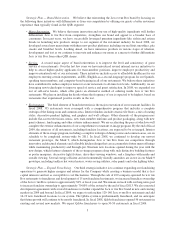Jack In The Box 2008 Annual Report Download - page 21
Download and view the complete annual report
Please find page 21 of the 2008 Jack In The Box annual report below. You can navigate through the pages in the report by either clicking on the pages listed below, or by using the keyword search tool below to find specific information within the annual report.Each of our restaurants competes directly and indirectly with a large number of national and regional restaurant
chains, as well as with locally-owned quick-service restaurants, fast-casual restaurants, sandwich shops and similar
types of businesses. The trend toward convergence in grocery, deli and restaurant services may increase the number
of our competitors. Such increased competition could decrease the demand for our products and negatively affect
our sales and profitability. Some of our competitors have substantially greater financial, marketing, operating and
other resources than we have, which may give them a competitive advantage. Certain of our competitors have
introduced a variety of new products and engaged in substantial price discounting in the past and may adopt similar
strategies in the future. Our promotional strategies or other actions during unfavorable competitive conditions may
adversely affect our margins. We plan to take various steps in connection with our on-going “brand re-invention”
strategy, including making improvements to the facility image at our restaurants, introducing new, higher-quality
products, discontinuing certain menu items, and implementing new service and training initiatives. However, there
can be no assurance (i) that our facility improvements will foster increases in sales and yield the desired return on
investment, (ii) of the success of our new products, initiatives or our overall strategies or (iii) that competitive
product offerings, pricing and promotions will not have an adverse effect upon our sales results and financial
condition. We have an on-going “profit improvement program” which seeks to improve efficiencies and lower costs
in all aspects of operations. Although we have been successful in improving efficiencies and reducing costs in the
past, there is no assurance that we will be able to continue to do so in the future.
Risks Related to Increased Labor Costs. We have a substantial number of employees who are paid wage rates
at or slightly above the minimum wage. As federal, state and local minimum wage rates increase, our labor costs
will increase. If competitive pressures or other factors prevent us from offsetting the increased costs by increases in
prices, our profitability may decline. In addition, various proposals that would require employers to provide health
insurance for all of their employees are currently being considered in Congress and various states. We offer access
to healthcare benefits to our restaurant team members. The imposition of any requirement that we provide health
insurance to all employees on terms materially different from our existing programs would have a material adverse
impact on our results of operations and financial condition.
Risks Related to Advertising. Some of our competitors have greater financial resources, which enable them
to purchase significantly more television and radio advertising than we are able to purchase. Should our competitors
increase spending on advertising and promotion, should the cost of television or radio advertising increase or our
advertising funds decrease for any reason, including implementation of reduced spending strategies, or should our
advertising and promotion be less effective than our competitors, there could be a material adverse effect on our
results of operations and financial condition. The trend toward fragmentation in the media favored by our target
consumers may dilute the effectiveness of our advertising dollars.
Taxes. Our income tax provision is sensitive to expected earnings and, as expectations change, our income
tax provisions may vary from quarter-to-quarter and year-to-year. In addition, from time to time, we may take
positions for filing our tax returns that differ from the treatment for financial reporting purposes. The ultimate
outcome of such positions could have an adverse impact on our effective tax rate.
Risks Related to Achieving Increased Franchise Ownership. At September 28, 2008, approximately 38% of
the JACK IN THE BOX restaurants were franchised. Our plan to increase the percentage of franchise restaurants and
move towards a level in the range of franchise ownership more closely aligned with that of the quick service
restaurant industry is subject to risks and uncertainties. We may not be able to identify franchisee candidates with
appropriate experience and financial resources or to negotiate mutually acceptable agreements with them. Our
franchisee candidates may not be able to obtain financing at acceptable rates and terms. Current credit markets may
slow the rate at which we are able to refranchise. We may not be able to increase the percentage of franchised
restaurants at the annual rate we desire or achieve the ownership mix of franchise to company-operated restaurants
that we desire. Our ability to sell franchises and to realize gains from such sales is uncertain. Sales of our franchises
and the realization of gains from franchising may vary from quarter-to-quarter and year-to-year, and may not meet
expectations. Risks Related to Franchise Operations The opening and success of franchised restaurants depends on
various factors, including the demand for our franchises, the selection of appropriate franchisee candidates, the
availability of suitable sites, the negotiation of acceptable lease or purchase terms for new locations, permitting and
regulatory compliance, the ability to meet construction schedules, the availability of financing, and the financial and
other capabilities of our franchisees and developers. See “Risks Associated with Our Development” above. We
13
























